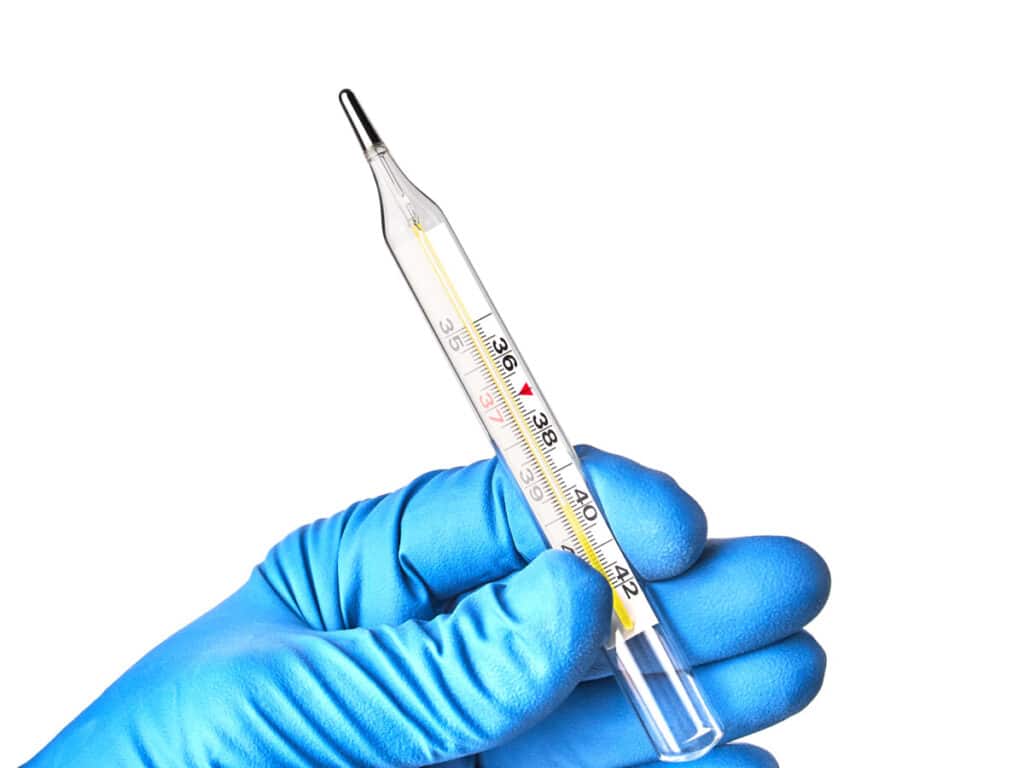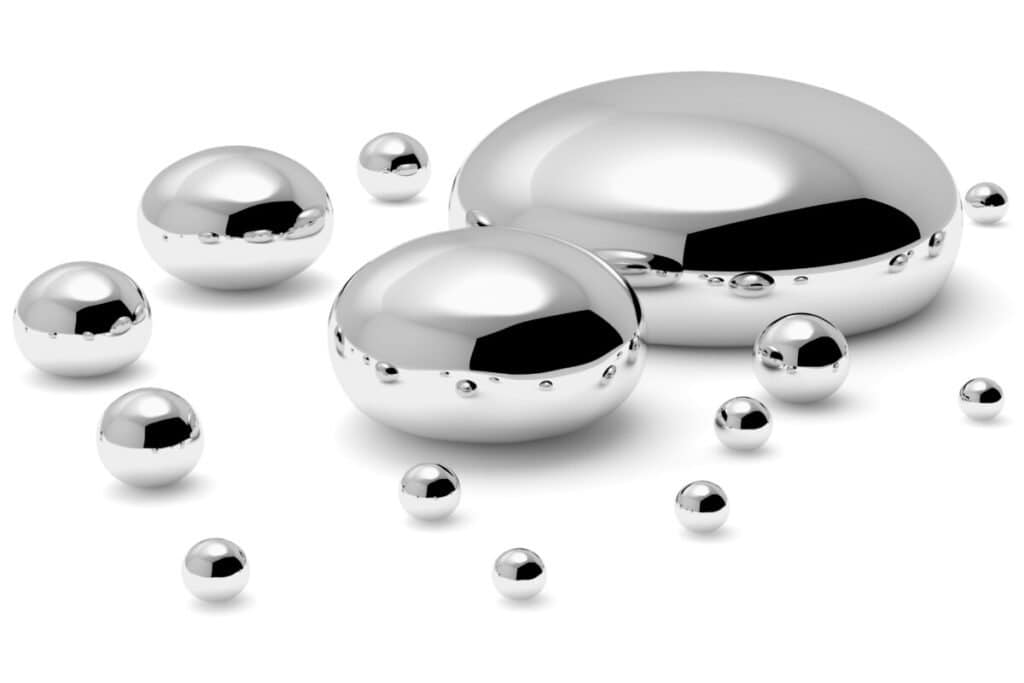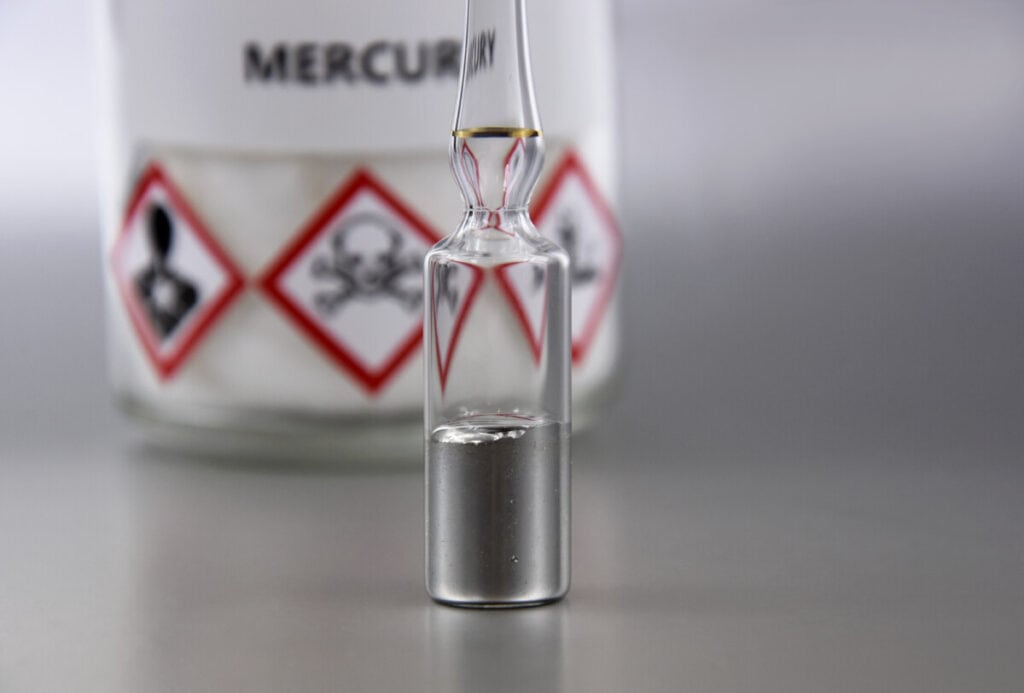
Mercury, the 80th element on the periodic table, is a shiny metal that is liquid at room temperature. Over the years, it has been used in thermometers, lightbulbs, jewelry-making, batteries, and more. It’s not uncommon for households to have an old mercury thermometer or thermostat somewhere around.
Mercury-containing products should be disposed of at a public mercury-collection facility, as putting mercury in the regular garbage can be dangerous to human and environmental health. It’s important to ensure that the glass casing is intact and no mercury can escape when disposing of a thermometer.
Disposing of mercury is not so simple as chucking an old thermometer in the bin, it requires planning and precaution. However, accidents can happen. It is important to understand the dangers of mercury and heavy-metal poisoning so that in the event of a spill, you know what to do.
What is Mercury?
Mercury, as previously mentioned, is a liquid metal. It is a dense, silvery-white substance, and has a high surface tension, breaking into tiny beads when touched. While other metals like Gallium are close to liquid at room temperature, mercury is the only metal that is liquid at room temperature. It can also evaporate slowly from room temperature. Though the element is fascinating and potentially entertaining to look at, it is not safe to touch. Unfortunately, the consequences of contact with mercury can be very hazardous to a person’s health.
Mercury is classified as a heavy metal— referring to its relative density compared to water. Unlike other forms of metals, heavy metals can be toxic when ingested. Ingestion is most often accidental, either from inhalation of aerosolized or evaporated mercury, or touching a contaminated surface. Because of its usefulness in various products, mercury was once quite common in a variety of products. Today, mercury is rarely found in household products because of its dangerous potential.
Mercury functions as a neurotoxin when ingested, and can lead to problems with vision, coordination, and mental capabilities. Some symptoms of mercury poisoning include tremors, insomnia, numbness, emotional mood swings, headaches, muscle twitching or spasms, and more. When left untreated, prolonged mercury toxicity can lead to kidney problems, respiratory failure, and death.

Disposing of Products Containing Mercury
Though there are a few products that contain mercury—fluorescent lightbulbs contain a small amount of mercury— mercury thermometers have the highest mercury content. Mercury fever thermometers can contain anywhere from 1-2 grams of mercury. For those who are unfamiliar with elemental concentration, that’s a lot. They are also the most common mercury-containing products still in existence, especially in older homes.
Not every liquid-containing thermometer has mercury in it. Newer thermometers can contain alcohol or other substances that compress and expand with heat similarly to the way mercury does. If a package has “mercury-free” on the label, you can know it’s non-toxic. You can also determine if a thermometer has mercury in it by observing the color of the liquid. If it is red or blue, then it’s more likely alcohol or some other substance. These thermometers are safe for disposal in regular garbage. Only suspect mercury when the internal liquid appears silvery or white.
When disposing of a mercury thermometer, first ensure that it is intact. Check for any chips or cracks in the glass and make certain that no mercury has escaped. In preparing for disposal, place it in a disposable container that it is not likely to roll around in— the more movement the thermometer has, the more likely it is to break.
Intact thermometers can be taken to your local household hazardous waste (HHW) facility. City waste disposal sites often have specific locations designated for mercury deposits. You can search for these locations or other nearby collection locations on websites such as ThermostatRecycle.org and Earth911.com. Some plumbing or hardware stores also have safe disposal sites you can make use of, though these are likely to cost a small fee.

How to Clean Up Spilled Mercury
Before starting clean up, take care not to spread the mercury over an even larger area. Because of its uniquely high surface tension and low melting point, mercury is at great risk of being scattered when not contained in its glass casing. Large droplets when touched will break into much smaller droplets and can travel surprisingly far with very little help from humans. The more mercury is scattered, the higher the likelihood and amount of mercury evaporating into the air.
There are a few things you should never do when cleaning up spilled mercury. Firstly, take proper precautions and don’t wear possibly contaminated clothing (i.e. shoes, gloves, socks, etc.) in other places, as this could spread microscopic mercury elsewhere. Secondly, never use a vacuum cleaner to collect mercury, as it will put even more mercury into the air, increasing your exposure. You should also never use a broom when cleaning mercury, as it will only break up the existing mercury and spread it over an even larger area. Finally, never pour mercury down the drain. This can not only cause plumbing issues, but it can pollute the septic tank or sewage treatment plant your home is attached to.
Have everyone who has not come into contact with the spilled mercury leave the area. Make sure to keep pets and other animals removed from the vicinity. Children should never be allowed to help clean mercury spills. Before cleaning begins, put on rubber or latex safety gloves. Open all outside doors and windows to increase circulation and decrease the potential amount of inhaled mercury, and close off doors and entryways to other areas of the house. This is to prevent the spread of mercury to further areas of the home.
A good— but smelly— way to keep spilled mercury from spreading is to dust it with powdered sulfur, available at some hardware stores, pharmacies, and gardening departments. The sulfur binds to the mercury and makes cleanup easier, as well as suppressing any mercury vapor from escaping. It is important to note that powdered sulfur is also toxic to inhale, so proper precautions are necessary when handling it.

Mercury is easiest to efficiently clean from smooth solid surfaces like wood, linoleum, and tile. Throw away all contaminated absorbent surfaces, like curtains, upholstery, carpet, or rugs. When dealing with mercury spills on carpet, only worry about cutting away the contaminated area for disposal. However, if the total area of contamination is for some reason unclear, it is far better to be safe than sorry.
Use a squeegee or cardboard to gather visible mercury beads into larger balls of mercury. Go slow and steady to avoid getting the mercury too “excited.” Roll the collected beads onto a paper towel and seal the paper towel and any materials used to gather them in a ziplock bag, labeled according to local health or fire department standards. Be sure to inspect the whole room for mercury beads, as they can scatter farther than you would think. A flashlight can be helpful in searching for reflective droplets.
Once done, place all cleanup materials, including gloves, in a trash bag. Place all collected mercury beads and objects (still in ziplocked bags) into the trash bag then place the bag outside in a secured area, clearly labeled according to safety standards. Contact your local health department, municipal waste authority, or your local fire department to find out how to properly dispose of the trash. You can find more detailed instructions here.
Keep the contaminated area well ventilated to the outside for at least 24 hours after cleanup to prevent inhalation of mercury vapor, and continue to restrict children and pets from the space. It may be a good idea to inquire after a contractor who can scan for mercury vapors or debris. Local environment or health agencies should have contact information for reliable contractors.
Related Topics:
If you like the article above, here are some other similar articles you should check out!
